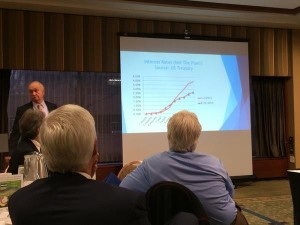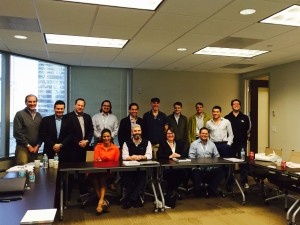As most of the United States recovers from one of the harshest winters on record, we are reminded that big storms are usually the result of unexpected conditions converging to produce volatile results. These “perfect storms” often result in catastrophic losses that leave us questioning how they could have been prevented or minimized.
 After recently attending risk management training in sunny Miami and an economic update breakfast in Portland, Ore., my colleague Jorge Cuevas and I were discussing the current condition of the coffee market and how we can help our customers and producers become better prepared for the next storm.
After recently attending risk management training in sunny Miami and an economic update breakfast in Portland, Ore., my colleague Jorge Cuevas and I were discussing the current condition of the coffee market and how we can help our customers and producers become better prepared for the next storm.
We see the conditions of a perfect storm for producers forming on the near horizon. As we look at where we are today versus the state of the market when we held our Let’s Talk Coffee® supply-chain gathering in Panama last October, there is more certainty about Brazil’s crop: Two months into 2015, Brazil’s rainfall levels continue to push coffee prices lower. Roasters are using disciplined hedging strategies to fix prices through the end of the year, and producers are benefiting from a strong U.S. dollar as they deliver coffee into a declining C-market. Because producers sell their coffee in U.S. dollars they have a favorable currency exchange, resulting in more U.S. dollars to apply toward their production costs. If the current trend for lower commodity prices continues, we can find some peace of mind in knowing that our fair trade producers are protected by the fair trade minimum, while our roaster partners have protected their costs through timely price fixing.
 At current market prices and currency levels, many growers in major producing countries such as Colombia and Brazil are not compelled to enter into price fixes. To some, the strategy has turned to waiting and hoping for a market rebound. Ironically this creates an out-of-balance position in the commodity futures market that may put further pressure to the downward pricing trend. Many roasters have already bought deep into September and even December. When the time comes to ship, there will be an avalanche of holdout sellers depressing prices even more, just as we saw during the week of February 16, ahead of March First Notice Day (a futures market deadline when all contracts must be settled and balanced). The fair trade minimum price will also come into play very soon as we approach a “C” level of $1.40, bringing complexities and new opportunities for our Relationship Coffee partners.
At current market prices and currency levels, many growers in major producing countries such as Colombia and Brazil are not compelled to enter into price fixes. To some, the strategy has turned to waiting and hoping for a market rebound. Ironically this creates an out-of-balance position in the commodity futures market that may put further pressure to the downward pricing trend. Many roasters have already bought deep into September and even December. When the time comes to ship, there will be an avalanche of holdout sellers depressing prices even more, just as we saw during the week of February 16, ahead of March First Notice Day (a futures market deadline when all contracts must be settled and balanced). The fair trade minimum price will also come into play very soon as we approach a “C” level of $1.40, bringing complexities and new opportunities for our Relationship Coffee partners.
So how should stakeholders prepare to weather this storm? Our advice is to go into the year informed and prepared. Sustainable Harvest® staff is actively engaged with our roaster and supply partners to devise the best tools and strategies under this volatile environment. It’s important to know how much risk you can tolerate and follow good enterprise risk management practices. Do not limit your analysis to price risk only. Understand your sensitivity to currency and interest rate changes, personnel or asset losses, environmental and business threats, and other identified risks. Know that if several of these factors occur simultaneously, it can result in your perfect storm.



.png)
